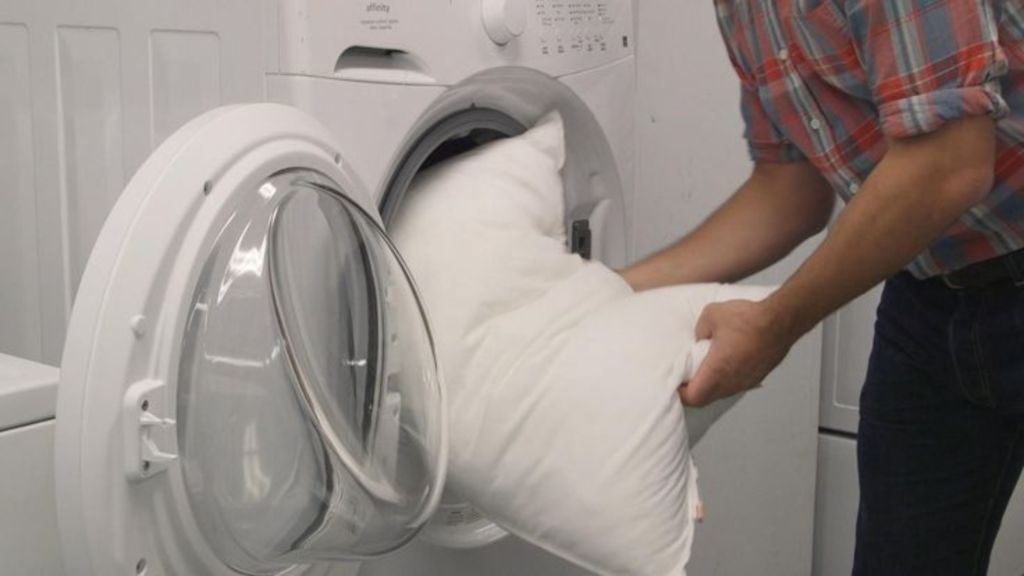Do you have dirty and smelly pillows at home? We’ve got solutions to your pillow problems. Pillows are important for a restful night’s sleep since they support and soothe our heads and necks. But over time, they may gather allergens, sweat, fluids, and dirt, which reduce their efficiency and cleanliness.

Source: Pinterest
This is why we’ve put together efficient ways to clean different kinds of pillows and how frequently to do it to maintain a healthy and comfortable sleeping environment.
Benefits of Cleaning Your Pillows
Pillows gather bodily fluids, dead skin cells, and dust mites over time. If they are not cleaned regularly, they can accumulate odors, turn yellow, and even cause health concerns like allergies and respiratory disorders.

Source: Pinterest
Clean pillows enhance sleep, personal hygiene, and general well-being. So if you’ve been falling sick and can’t figure out why, your pillows might be the problem.
How Frequently Should You Wash Your Pillows?
The frequency at which you should wash your pillows is affected by the kind of pillow, usage, and personal hygiene. Pillows should generally be cleaned every three to six months to avoid the accumulation of dust and allergies.

Source: Pinterest
However, pillows used by people who have asthma, allergies, or heavy perspiration may require more frequent cleaning, ideally once every one to two months.
Synthetic Pillows
Synthetic pillows, like polyester-filled pillows, are machine washable. Use a mild detergent and select a gentle cycle with warm water for washing in your washing machine.

Source: Pinterest
Remember to add an extra rinse cycle to ensure the detergent residue is thoroughly removed. Dry the pillows on a low heat setting or air dry them outdoors.
Down And Feathered Pillows
Down and feathered pillows, on the other hand, need special maintenance to keep them fluffy and tender. For precise washing instructions, see the care label or think about having it professionally dry-cleaned.

Source: Pinterest
Additionally, stay away from strong chemicals, a gentle detergent designed for fragile fabrics should be used. Use a dryer or tennis balls to dry the pillows to fluff and redistribute the filling.
Memory Foam Pillows
Memory Foam pillows shouldn’t be machine-washed or immersed in water. Use a solution of water and mild detergent to spot clean dirt spots, and then dab with a fresh cloth.

Source: Pinterest
The cushion should be left to air dry entirely out of direct sunlight and in a well-ventilated room. Use a vacuum cleaner equipped with a brush attachment for routine removal of surface dirt and debris.
Latex And Bamboo Pillows
Lastly, Latex and Bamboo pillows are generally allergy-free and dust-mite-proof. You only have to pay attention to the cleaning and maintenance instructions provided by the manufacturer and follow them carefully.

Source: Pinterest
You can remove spots quickly by using a mix of warm water and a light detergent. Make sure to let them air-dry completely before reusing the pillows.
How To Get Rid Of Stink In Pillows
After washing your pillows, you can target any residual odors by flipping them over and leaving them in the open for a few hours in the sun to help them smell better and freshen up. Alternatively, mix bicarbonate soda or baking soda into the pillows and let them sit for a few hours.

Source: Pinterest
Think about hiring a professional cleaning service to thoroughly remove the smell from your pillows. Expert cleaners can fully clean and sanitize pillows using their special tools.
Pillow Refreshers
Using pillow refreshers can help you maintain the fresh scent of your pillows in between washings. You can use store-bought or handmade pillow refreshers. This can help you sleep better.

Source: Pinterest
Baking soda, water, and essential oils are examples of natural substances that can be used to make homemade refreshers. To use, just mist your pillows with the refresher and let them air dry.
Tips for Maintaining Clean Pillows
To reduce exposure to sweat, fluids, and dirt, place a barrier between your pillow and pillowcase using pillow protectors or pillowcases. Select breathable or waterproof protectors for increased defense against sweat and liquids.

Source: Pinterest
Avoid eating or drinking in bed to reduce the possibility of spills and stains on your pillows. Keep your pets off the bed to lessen the buildup of germs and pet fur on your pillows.
Frequent Pillow Rotation
Frequent pillow rotation can help you maintain your clean pillows. Make sure to turn your pillows frequently to guarantee uniform aging. Try to switch up your pillow placement every few weeks or when your bedding is washed.

Source: Ron Lach/Pexels
You can keep your pillows from being lumpy or deformed over time by rotating them from time to time for even distribution and to avoid flat spots in your pillows.
Conclusion
Maintaining hygiene, extending the lifespan of your pillows, and creating a healthy sleeping environment all depend on your routine pillow cleaning. It is important to regularly inspect your pillows from time to time for evidence of wear, damage, or the accumulation of allergens.

Source: Pinterest
Look for areas that have flattened or formed lumps or clusters that might suggest replacement. It could be time to get new pillows if you see any holes, tears, or strange smells.
